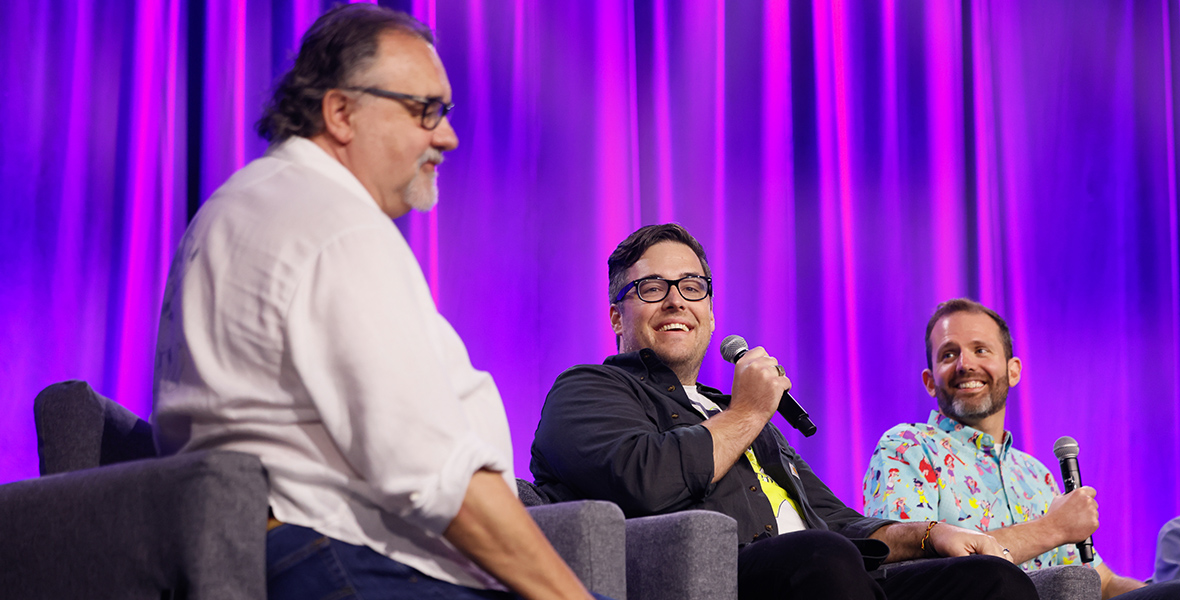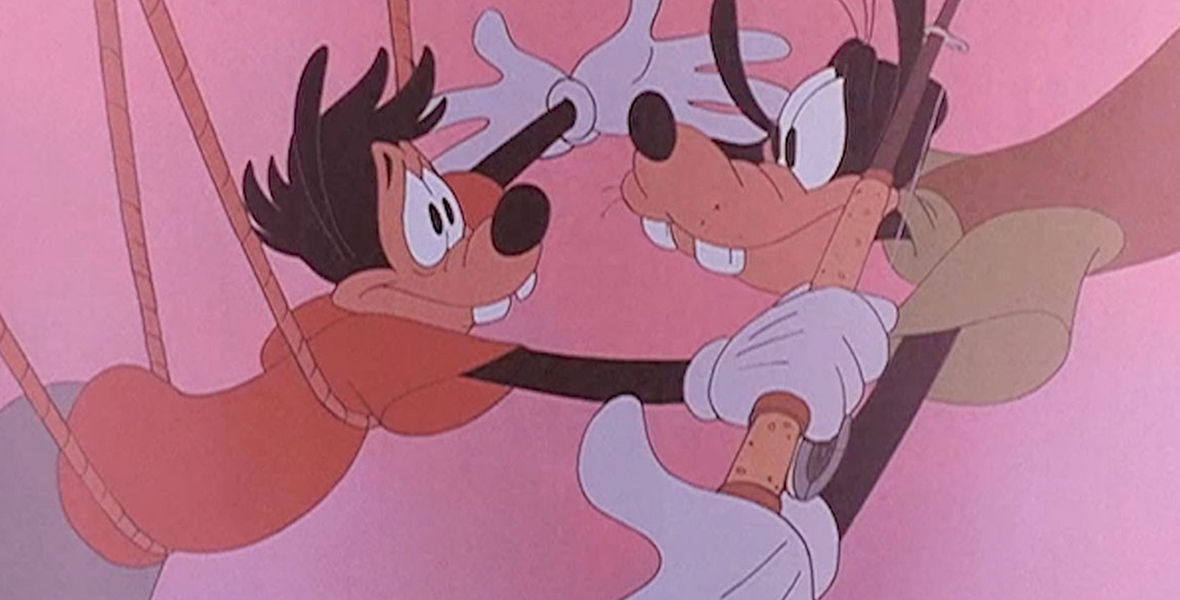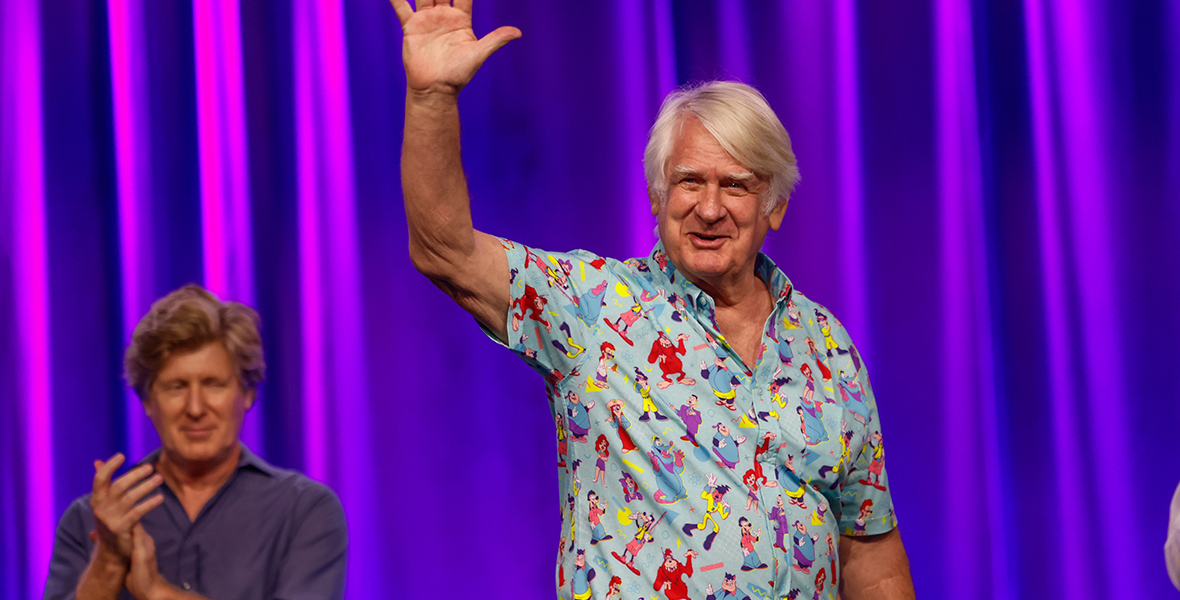By Courtney Potter
It’s been nearly 30 years since A Goofy Movie debuted in theaters—and in the ensuing decades, it’s become a veritable fan favorite. So it’s no wonder that filmmakers Eric Kimelton and Christopher Ninness have chosen to explore the making of A Goofy Movie in a brand-new documentary. And it’s only natural they’d want to honor both the film’s upcoming anniversary and this new documentary at D23: The Ultimate Disney Fan Event with a legion of fans, who filled the Walt Disney Archives Stage on Friday evening for a rollicking look at the past, present, and future of Goofy and Max’s heartfelt and hilarious father/son adventures.

Joining the filmmakers onstage for the panel, titled “Making A Goofy Movie: The Road to Lake Destiny,” was our moderator for the evening, Disney Legend Don Hahn, as well the director of A Goofy Movie, Kevin Lima, and Hahn’s fellow Disney Legend—the voice of Goofy—Bill Farmer! Also on hand for the celebratory occasion were head of story Brian Pimental, animation sequence director and storyboard artist Steve Moore, and editor Greg Perler.
Besides showing clips from the still-in-production documentary, Lima and friends delved into several memorable behind-the-scenes stories from the making of A Goofy Movie. Like Goof and Maxie, head out “on the open road” and read on for some highlights:
How Lima came to direct the film:
“I got a phone call one day, and they asked whether or not I’d consider taking over the directing duties on the piece,” Lima explained. “I often say that so much of what happens to us has to do with luck—I was in the right place at the right time, wanting to do the work. I had asked to do the work; I had said I wanted to be a director, and they knew that… I thought we had the opportunity to make a John Hughes movie in animation. Let’s make a movie that’s about contemporary teenagers.”
On the tone of the finished product:
As Pimenthal explained, “Right from the start, we thought it was a comedy—but [then Walt Disney Studios chairman] Jeffrey Katzenberg really pushed for the film’s heart. He wanted us to dig deeper; he wanted it to feel like a real father son relationship. That made sense in hindsight. At the time, though, we thought, ‘We’re not going to be able to do what we’re used to seeing Goofy do,’ you know? But we realized we’d be able to do both.”
“Most of my contemporaries were upset with me for bringing deep emotion to Goofy,” continued Lima, eliciting chuckles from the audience. “They didn’t understand, because it had never been a part of his character up to that point. But we all really felt like the only way to survive on a 75-minute journey was to have there be some strong emotion at the center of it. When we clicked into that idea—that there was going to be this is sort of odd, I guess, ‘pain’ in A Goofy Movie—we were able to discover new things. And in discovering those new things, I think it made the movie click in the way that it has.”
Why a certain sequence in the film means a lot to one of the documentary’s directors:
“A Goofy Movie means so much to us—because on emotional level, it hit us at a pivotal moment in our lives,” admited Ninness. “I was 5 years old when A Goofy Movie came out, it was a time in my life where I wasn’t connecting as much to my father. ‘Hi Dad Soup’ has always been my favorite scene in the film, and I could never quite articulate why I loved it so much. This was the first scene we edited for the documentary. When we found the footage we just showed—which, so you have some context, is Kevin would film himself and send the tapes off to [the Disney Animation studios in] Paris, since he was in Burbank, and that’s how he would be able to direct them—and he’s breaking down the scene beat by beat. Anyway, I would watch ‘Hi Dad Soup’ over and over and over because it was the first time I got to really hear someone articulate how I was feeling as a kid. So to see Kevin’s footage… it makes the scene even better for me now as a 35-year-old.”

On which scene has grown on Farmer over the years:
“It sounded the most like me,” the iconic voice actor explained, “which bothered me when I first saw it. Because I thought, ‘That’s too much me; I’m not doing enough Goofy!’ I was trying to split between me and Goofy, to give the Goofy qualities and still have the nurturing father and the worry and all of the reality that the scene needed. But over the years, I’ve come to love that scene because it is the most real and heartfelt and shows the depth that Goofy’s emotions can go. And that was difficult to add—because Goof Troop, which was my first series before A Goofy Movie, was Saturday morning, high-energy fun. And we didn’t have to add layers of emotion to this character that he’d never had before. So that was the hard part—and I’m glad that we stuck through it and worked on it over the couple of years and the many, many recording sessions, to add that depth of emotion. Because it stands the test of time.”
On editing “I 2 I,” and why it stands out from the crowd (so to speak) as a favorite:
As Perler admited, “Trying to keep the story going—intercutting between the story that was Goofy and Max getting into the stadium and also showing Powerline [performing]—was a really delicate balancing act. I remember it being thoroughly storyboarded. The song [“I 2 I”] was so perfect; we never really edited the song or anything. And there’s a modulation in the song at a certain point, and we said, ‘Okay, that’s when they come together on stage,’ and you just work backward from there. Some of the shots in there are ‘blink and you miss ’em.’ I mean, they’re eight frames! And you still had to keep that Goofy and Max where they were, [then show them as] they got separated, [then] we’ve got to get them back together—oh, and kids are watching this all on TV, which was part of the story. So yeah, it was a real juggling act.”


